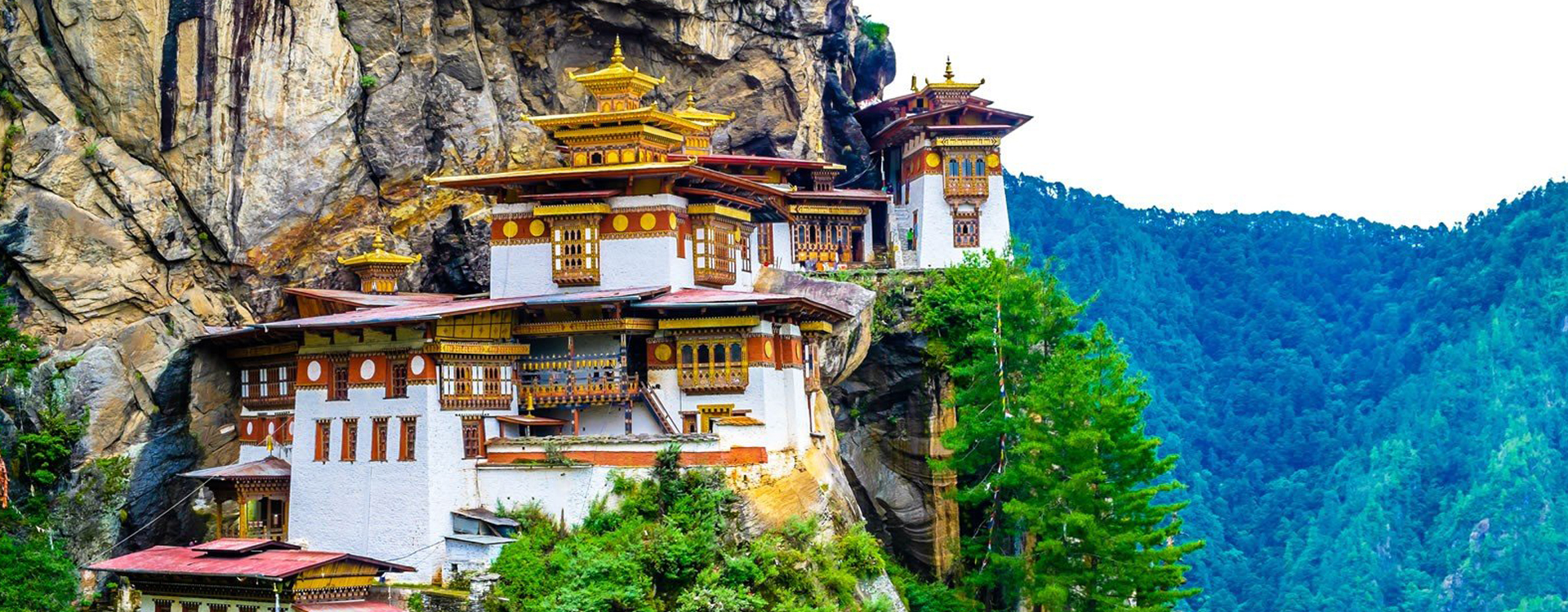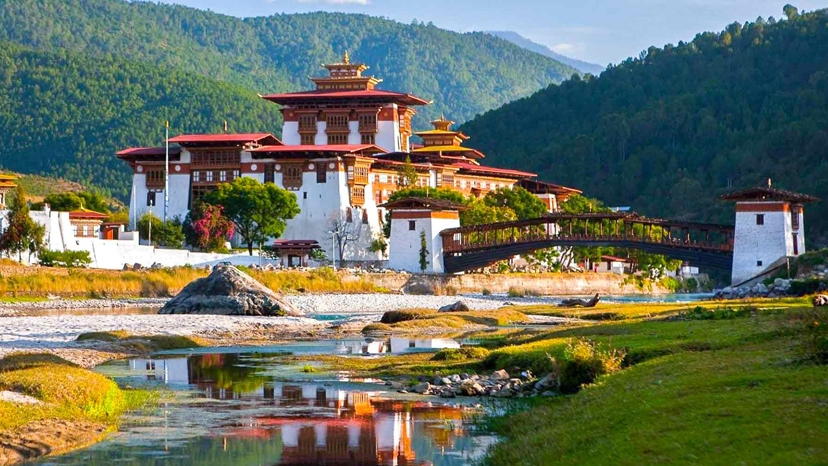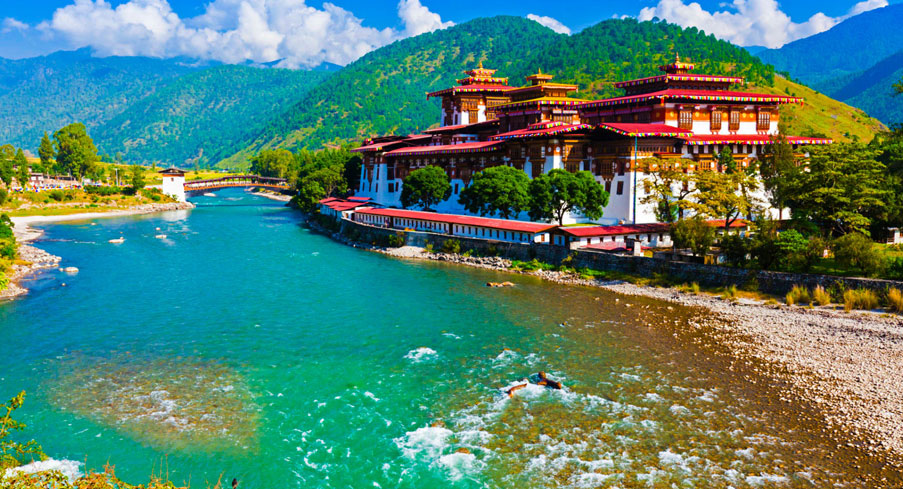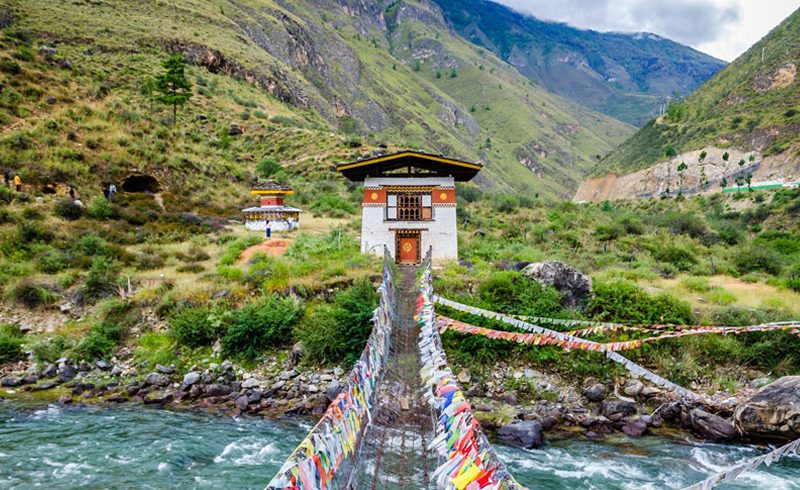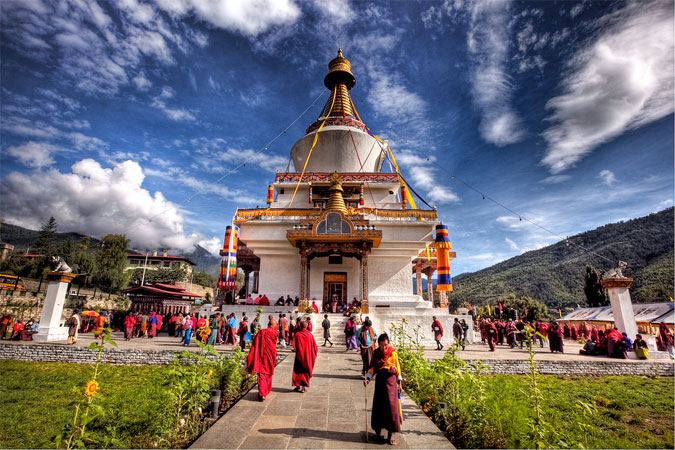Trip Facts
Overview
Paro – Thimpu Sightseeing – Trongsa – Bumthang sightseeing – Punakha – Paro
Itinerary
Fly onboard Druk Air to Paro, Bhutan. On a clear day the panoramic views of the Himalaya are sensational, including Everest, but particularly exciting is the approach through the Bhutanese foothills and the landing, including a few steep turns to land at the tiny airstrip of Paro. In Paro you will be received by your Bhutanese guide and transferred to the capital town of Thimpu (1 hr drive).
There are a good many things to see in the capital which has a very relaxed, laid-back feel about it. Thimpu is relatively small having a population of approximately 90,000 people and the streets are wide and tree lined. You will almost certainly visit the Late King’s Memorial Chorten, the National Library, Drubthob Nunnery, Folk Heritage Museum, Takin Preserve, the handmade paper factory, the school of arts and crafts where young students learn the traditional arts and crafts (Zo Rig Chusum – the thirteen crafts), Gold and the Silver Smiths workshop, Zangtopelri Lhakhang, and the Handicraft Emporium and the local handicraft centers to see the weavers at work and also varieties of textiles, thangka paintings, masks, jewellery etc.
In the morning, we drive to Punakha (3 hrs. drive), the old winter capital. Leaving Thimpu the road climbs via a series of zigzags over the Dochu La Pass, 10,000ft/3,048m. On a clear day panoramic views can be had of the eastern Himalaya, including Bhutan’s highest mountain, Gangkar Punsum, 24,770ft/7,550m. The road drops down through varied forest finally emerging into the highly cultivated Punakha valley.
In the afternoon hike to Chimi Lhakhang, the divine mad monk’s temple. It is a beautiful walk through a lovely village. The temple can be visited and there is a tree outside which is supposed to have sprouted up after Drukpa Kunley sent a thunderbolt from an adjoining valley to kill some evil spirits who had gathered at the site.
Also visit the courtyard of Punakha Dzong and drive to Wangdue to view Wangdi Phodrang Dzong.
Drive to Gangtey, which takes about 3 hours. First drive south to Wangdiphodrang and make a quick stop here for pictures. Then continue drive towards east, passing many little villages and gradually climbing up the black mountains. About ½ hr before the Pele pass, a small road diverts to Phobjikha valley. Visit Gangtey gompa monastery and in the evening, you can take a walk the valley.
Visit 15th century Gangtey Gompa temple on hilltop, Explore the valley and watch rare black naked cranes, the winter homes that migrate from Tibet.
After the sightseeing return back to Punakha.
Start early for drive back to Thimpu, which takes about 3 hours. En-route stop at Dochula cafeteria for tea and views.
Continue drive to Paro, which takes another 1 hour. Your lunch may be in Thimphu or Paro. In Paro, take an hour-long tour of the National Museum, visit Rinphung Dzong.
This morning a scenic drive of 1 & ½ hr will bring us to Chele La pass at an altitude of aprrox. 3900m/1300ft. On one side is the Paro and on the other side is Haa valley. The hike of this morning begins from a short descent below the pass. It is about a half hour uphill and shorter coming down hill. The hike brings you to a clusters of shelters built on sheer cliffs, under the rock/cave and a temple that houses some 50 or so nuns.
On your way back to Paro, we will stop at a place for the hike to a monastery called Dzondrakha which looks similar to famous Tiger’s Nest monastery but located at shorter hiking distance. Half the walk will be along the agricultural field and very easy, another half will be an uphill climb and when both versions of hikes are summed up it will take less than 1 hour to reach at the top where the monastery stands. On reaching the site of the monastery, one would enjoy the view of the fertile Paro valley below. Your guide will take you inside the main temple of the monastery.
Walk back to the point to meet the transport and drive to Paro and visit Bhutan’s national museum, a fascinating place housed in an old watchtower above the huge Paro Dzong. You will also visit Rinphung Dzong (a dzong is a fortress-monastery).
In the morning hike to the Tiger’s nest, afternoon visit Dungtse Lhakhang and Kichu Lhakhang
Taktshang – Tiger’s Nest: Tiger’s Lair or Tiger’s Nest as it often referred to for Taktshang Pelphung monastery, is one of the most venerated and famous of Bhutan’s monasteries. It is located on the face of a sheer 900m cliff above the floor of Paro valley. It is an impressive and un-miss-able sight but accessible only by walk or to ride mules/pony. If you need the riding horse, you must ask your local guide to arrange it on the previous day. From the trail head (2600m), the walk till the Cafeteria is a steep one hour uphill (about 350m ascent). From the Cafeteria (2940m) and areas around it, one can get a good close-up view of Taktshang. Savor views of the monastery over a well-deserved cup of tea and biscuits at the cafeteria.
For those who wish to proceed further from here, one must be able to walk. Usually Ponies/horses will not take people beyond this point and neither will they take you downhill. From the cafeteria, trail continues uphill for another 45 minutes to a high observation point (3140m) where there is a Chorten (stupa). From this vantage point, the lookout to the monastery is a very spectacular and seems almost close enough to touch. It is now on the other side of a deep chasm, only around 150m away as bird flies, but takes half hour or even more to reach. Continue down the flight of cliff-hanging steps on the narrow trail to a beautiful waterfall that plunges down the deep chasm and alongside is a retreat hermitage, jammed dramatically into a rock crevice. Then climb up the flight of steep steps to the monastery. At any point on this walk, you can always return if you find it too difficult. Once inside the monastery, there are several shrines or temples to see with few monks in residence. After visiting Taktshang monastery’s many shrines, most tours schedule lunch at the Cafeteria upon return. After lunch, retrace back to the road-head where you started in the morning. The retrace back is all downhill and always on foot as it is not suitable for riding pony/horse. Please note that proper walking boots is recommended for this hike. Further, if you have more time and ready for more challenging day, there are several monasteries, temples, retreat houses in the surrounding area of Taktshang. The most notable among them are Zangdopelri and Ugyen Tsemo as described seperately.
According to the legend, Guru Padmasambhava or Guru Rinpoche, who spread the Buddhism across the entire Himalayas is said to have flown here in the 8th century on the back of a Tigress, in order to subdue negative spiritual forces that were hostile to spread of Buddhism. In 853, one of his students, Pelgyi Senge mediated here in the main cave. A Stupa inside one of the temples contains his mortal remains and therefore the cave is known as ‘Pelphung ‘or ‘Pelgi’s cave’. Subsequently many great spiritual masters such as Milarepa, Thangthong Gyalpo, Phajo Dugom Zhigpo, Shadrung and many others passed periods here in profound meditation. In 1692, Tenzin Rabgye built a two storey temple around what little may have existed previously. This was expanded and refurbished many times over the period of time. Taktshang and several temples in the area were burnt down in 1951 by fire accident but much of them remained intact and most of the relics were saved. Soon after, it was rebuilt by entire population of Tsento village. Again in April of 1998, a major fire destroyed the main structure of the building and it’s contents. Reconstruction began in 2000 and was completed and consecrated after extensive efforts and financial support of Governments as well as donors.
Kichu Lhakhang: Kyichu is one of the oldest temples in Bhutan built in the 7th century by Tibetan King Songtsen Gampo. The story goes that a giant demoness lay across Tibet and the Himalayas, which was preventing the spread of Buddhism. To overcome her, King Songtsen Gampo decided to build 108 temples in a single day to pin the ogress to the earth forever in 659AD. Of these 108 temples, 12 were built in accordance with precise plans at key points. The temple of Jokhang in Lhasa was built over the very heart of the demoness and Kichu is said to have been built on the left foot.
Dungtshe Lhakhang: Dungtse Lhakhang was constructed by the great bridge-builder Thangtong Gyelpo in 1433. It is said to have been built on the head of demoness, who was causing illness to the inhabitants. The building was restored in 1841 and is a unique repository of Kagyu lineage arts. You may or may not be permitted inside but can walk around this three-storey Chorten-type building.
Beyond Takstang Description: Takstang (Tiger’s Lair) – or Taktsang Pelphung is one of the most venerated and famous of Bhutan’s monasteries. It is located on the face of a sheer 1000m cliff above Paro valley. It is an impressive sight but accessible only by trek or on pony.
The walk to the Tea house is a steep one hour uphill (about 350m ascent). From the tea house or Cafeteria (2940m), one can get a close-up view of Takstang and most actually return back from here. After tea, snacks and rest, we will trek further uphill to a high observation point (3140m), where there is a Chorten (stupa). Continue down the flight of cliff-hanging steps on the narrow trail to a beautiful waterfall that plunges down the chasm and alongside is a retreat hermitage.
Legend has it that Guru Padmasambhava, the great Buddhist master of Oddiyana (present day in Pakistan), who spread the Buddhism across the entire Himalayas is said to have flown here in 8th century on the back of a Tigress, to subdue negative spiritual forces that were hostile to spread of Buddhism. In 853, one of his students Pelgyi Senge mediated here in the main cave. A Stupa at the main cave contains Pelgyi’s mortal remains and therefore the cave is therefore known as Pelphung or Pelgyi’s cave. Subsequently many great spiritual masters passed periods here in profound meditation. In 1692, Tenzin Rabgye built a two storey temple here, which over the period of time was expanded and refurbished. In April 1998, tragically, two of the three temples were completely burnt by fire. It has now been restored to its original splendor. After returning from the visit to monastery, we will hike further uphill from the observatory point (described earlier) to Zangdopelri temple (3250m). From here, we can actually look down on the temple, with air distance of not more than 500 meters, providing a unique view. Then if you are can, we can trek for another ½ hour further up to Ugyen Tsemo temple with great view of the valley. Depending on the trail conditions, after Ugyen Tshemo, you can walk back using different route which joins at the end. Return to Paro.
Drukgyel Dzong: Drukgyal Dzong ruins is located 14kms north of Paro town, near the end of the paved road. Drukgyal Dzong (victories fortress) was built around 1644-49 to commemorate the Bhutanese victory over the Tibetan-Mongol forces. It was later burnt in fire accident in 1951. On a clear day, Mt. Chomolhari, Bhutan’s holy peak is seen against its backdrop.
After breakfast, drive to Paro International airport for onward destination.
Consumer reviews
REVIEW REQUESTS
Enter a recent customer’s contact info and we’ll ask them to leave you a review.



